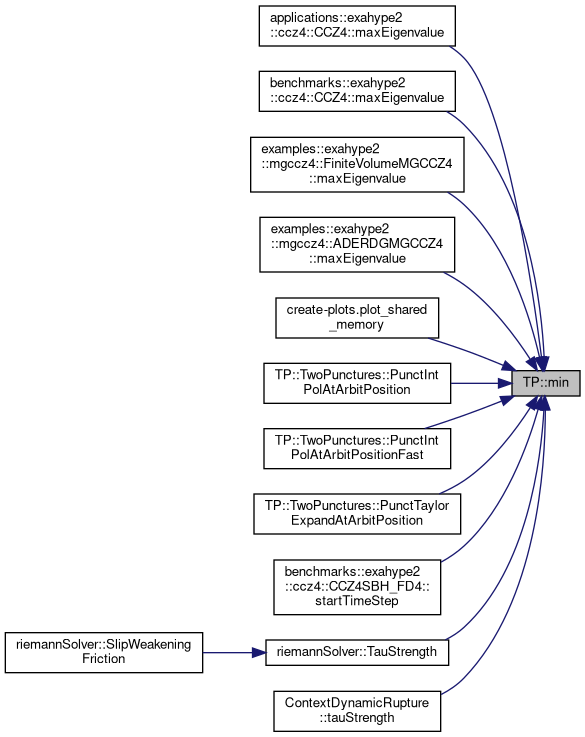|
Peano
|
|
Peano
|
This file contains aliases for making access to the long state vector Q as used eg. More...
Namespaces | |
| namespace | Utilities |
| namespace | Z4VectorShortcuts |
Data Structures | |
| struct | DERIVS |
| class | error |
| Another nice thing: The TwoPunctures Error, borrowed from Pizza. More... | |
| struct | logger |
| By inheriting this class, you can do something with output if you need. More... | |
| struct | LoggingAdapter |
| The LoggingAdapter: Logging in Cactus/printf style without macros. More... | |
| struct | Parameters |
| struct | std_cerr_logger |
| Default stdout logger, using iostream. More... | |
| class | TwoPunctures |
Typedefs | |
| typedef struct TP::DERIVS | derivs |
Enumerations | |
| enum | GRID_SETUP_METHOD { GSM_Taylor_expansion , GSM_evaluation } |
Functions | |
| static double | min (double const x, double const y) |
| void | recurrence (double x, int m, double *recvec) |
| double | chebev_wrec (double recvec[], double coeff[], int m) |
| int | TP_MyProc () |
Variables | |
| const int | StencilSize = 19 |
| const int | N_PlaneRelax = 1 |
| const int | NRELAX = 200 |
| const int | Step_Relax = 1 |
This file contains aliases for making access to the long state vector Q as used eg.
in ExaHyPE and at the functional interface of this code, more readable.
With these constants, you can write Q[g11], Q[K22] and Q[B33] instead of Q[0], Q[9] and Q[34]. Your code is again meaningful in terms of physics.
The list os converted from the PDENames function from Trentos Fortran code with this expression:
perl -p -i -e "s/^\s+Name\((.*)\)\s* = '(.+)'/\"const int \$2 = \".(\$1-1).';';/eg" FileHoldingPDEDefs.tmp
Methods have been implemented already in the ExaHyPE SRHD application to deal even more naturally with physical expressions which are stored in a long and unintuitive vector. See end of this file for comments.
| typedef struct TP::DERIVS TP::derivs |
| Enumerator | |
|---|---|
| GSM_Taylor_expansion | |
| GSM_evaluation | |
Definition at line 34 of file TwoPunctures.h.
| double TP::chebev_wrec | ( | double | recvec[], |
| double | coeff[], | ||
| int | m ) |
Definition at line 906 of file FuncAndJacobian.cpp.
Referenced by TP::TwoPunctures::PunctEvalAtArbitPositionFaster(), and TP::TwoPunctures::PunctEvalAtArbitPositionFasterLowRes().

|
static |
Definition at line 21 of file FuncAndJacobian.cpp.
Referenced by TP::TwoPunctures::PunctIntPolAtArbitPosition(), TP::TwoPunctures::PunctIntPolAtArbitPositionFast(), and TP::TwoPunctures::PunctTaylorExpandAtArbitPosition().

| void TP::recurrence | ( | double | x, |
| int | m, | ||
| double * | recvec ) |
Definition at line 896 of file FuncAndJacobian.cpp.
Referenced by TP::TwoPunctures::PunctEvalAtArbitPositionFaster(), and TP::TwoPunctures::PunctEvalAtArbitPositionFasterLowRes().

| int TP::TP_MyProc | ( | ) |
Definition at line 24 of file TwoPunctures.h.
Referenced by TP::TwoPunctures::F_of_v(), and TP::TwoPunctures::set_initial_guess().

| const int TP::N_PlaneRelax = 1 |
Definition at line 16 of file Newton.cpp.
Referenced by TP::TwoPunctures::relax().
| const int TP::NRELAX = 200 |
Definition at line 17 of file Newton.cpp.
Referenced by TP::TwoPunctures::bicgstab(), and TP::TwoPunctures::TestRelax().
| const int TP::StencilSize = 19 |
Definition at line 15 of file Newton.cpp.
Referenced by TP::TwoPunctures::bicgstab(), and TP::TwoPunctures::TestRelax().
| const int TP::Step_Relax = 1 |
Definition at line 18 of file Newton.cpp.
Referenced by TP::TwoPunctures::TestRelax().